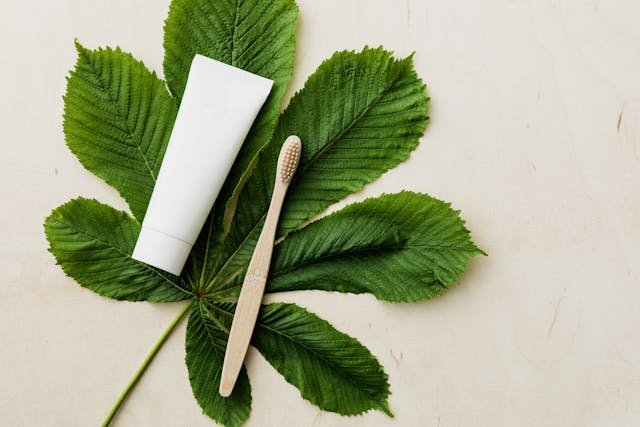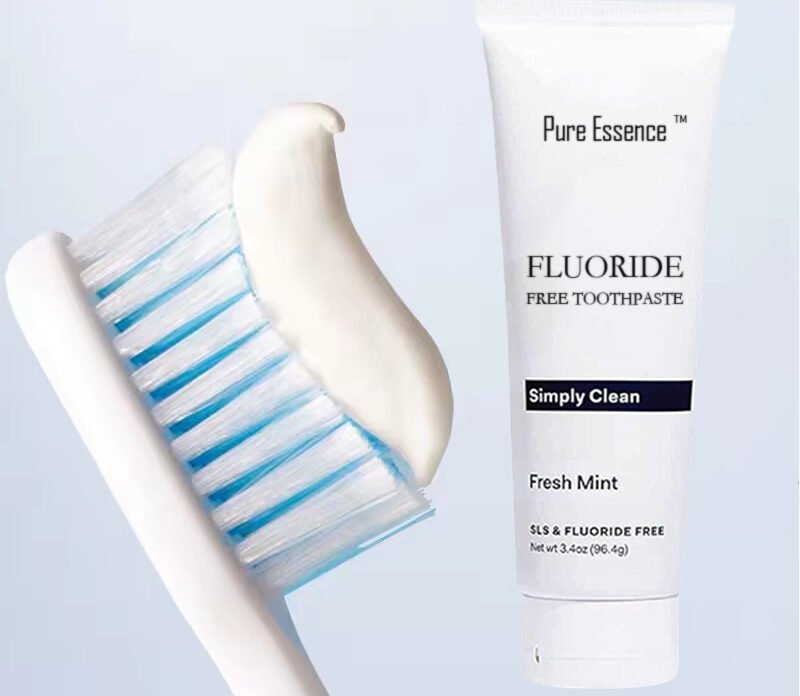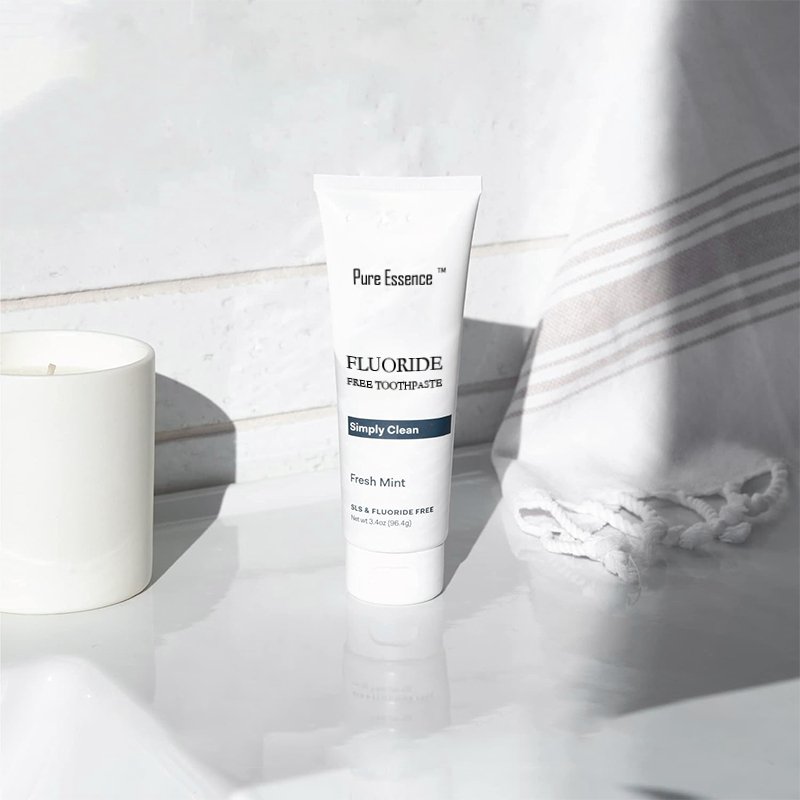Оглавление
Выбор лучшей зубной пасты может быть невероятно сложным, и, когда вы стоите перед десятком разных вариантов, каждый из которых обещает более белые зубы, более здоровую эмаль или мгновенное избавление от чувствительности, сделать выбор непросто. Если вы когда-либо страдали от кариеса, повышенной чувствительности дёсен или той острой боли, когда едите что-то холодное, то вы не одиноки. Миллионы людей страдают от этих же проблем, но мало кто знает, какая зубная паста для чувствительных зубов действительно помогает.
Здесь мы сосредоточились на двух наиболее часто рекомендуемых вариантах уход за полостью рта: зубная паста с фтором, которая укрепляет эмаль и предотвращает кариес, и зубная паста для чувствительных зубов, которая успокаивает нервные окончания и уменьшает боль. Мы расскажем вам об их основных преимуществах, о том, как их использовать и чего следует избегать, чтобы вы могли сделать осознанный и уверенный выбор.
Независимо от того, страдаете ли вы от хронической чувствительности или просто хотите сохранить идеальную улыбку, эта статья для вас. Она включает в себя эффективные, основанные на фактических данных решения и рекомендации по зубной пасте для поддержки вашей практики гигиены полости рта без догадок.

Фторид: правда о его способности бороться с кариесом
Фтор — это природный минерал, защищающий зубы от одной из самых распространённых проблем — кариеса. Он содержится в небольших количествах в продуктах питания, напитках и даже воде, а также в виде пищевой добавки. Фтор укрепляет зубную эмаль и делает её более устойчивой к воздействию кислот, зубного налёта и сладостей. Когда кислоты, содержащиеся в пище и напитках, разрушают эмаль (деминерализация), фторид спасает положение, укрепляя и восстанавливая деминерализованные участки поверхности зубов посредством реминерализации. Эта процедура не только останавливает начальный кариес, но и может обратить его вспять на ранних стадиях. Кроме того, его антимикробное действие помогает остановить рост бактерий, вызывающих кариес.
Научные данные продолжают подтверждать эффективность фтора. Американская стоматологическая ассоциация (ADA), Всемирная организация здравоохранения (ВОЗ) и Центр по контролю и профилактике заболеваний (CDC) рекомендуют использовать фторид для гигиены полости рта. Исследования показывают, что зубная паста с фтором может снизить риск развития кариеса на 24% как у детей, так и у взрослых. Таким образом, фторид является одним из наиболее изученных и надежных ингредиентов, используемых в современных стоматологических средствах. Некоторые называют его «стоматологическим супергероем».
Тем не менее, некоторые люди беспокоятся о безопасности фтора. Один из распространённых мифов заключается в том, что фтор вызывает рак, но нет убедительных научных доказательств, подтверждающих это утверждение. Крупнейшие организации здравоохранения во всём мире подтверждают, что фтор в контролируемых количествах безопасен для ежедневного использования.
Однако настоящую проблему представляет флюороз зубов, при котором на развивающихся зубах появляются едва заметные белые пятна или шершавые коричневые полосы. Это заболевание встречается только у детей младше 8 лет, которые потребляют слишком много фтора в период формирования зубов. Поэтому дети старшего возраста, подростки и взрослые не подвержены этому заболеванию. Чтобы предотвратить флюороз, детям следует использовать зубную пасту размером с горошину и избегать её проглатывания. Родители должны контролировать чистку зубов до тех пор, пока дети не научатся правильно полоскать рот и сплевывать, что обычно происходит в возрасте шести-семи лет.
Для взрослых фторид считается безопасным при использовании по назначению. Зубная паста, ополаскиватель для полости рта и очищенная вода содержат низкое количество фторида, которое вполне соответствует безопасной суточной норме. Регулярное применение фторида способствует укреплению эмали, предотвращает ранний кариес и снижает долгосрочные расходы на стоматологическое обслуживание и дискомфорт.
Короче говоря, фторид не просто полезен, он необходим для защиты зубов от ежедневного износа и кариеса. Он работает незаметно, восстанавливая эмаль и сохраняя ваши зубы жемчужно-белыми, здоровыми и без кариеса.

Борьба с чувствительностью зубов: причины, облегчение и выбор правильной зубной пасты
Чувствительность зубов может превратить такие простые действия, как питье холодной воды или чистка зубов, в болезненные ощущения. Проблема часто начинается, когда защитная эмаль зуба изнашивается или ваши десны начинают отступать. Эмаль может разрушаться из-за слишком сильной чистки, частого употребления кислой пищи и жидкостей, скрежетания или стискивания зубов. Заболевания десен, чрезмерная чистка зубов и генетическая предрасположенность могут отодвинуть десну и обнажить поверхность корня зуба. Это обнажает дентин, внутренний слой вашего зуба. Дентин имеет микроскопические трубочки (дентинные канальцы) с нервными окончаниями. Когда тепло, холод, сладкая или кислая пища, воздух или прикосновение воздействуют на открытые дентинные канальцы, эти нервы реагируют острой болью.
Зубные пасты для чувствительных зубов разработаны для снижения чувствительности и защиты уязвимых участков при длительном использовании. Они либо блокируют нервные импульсы, либо защищают обнажённый дентин, не давая раздражителям добраться до нервов.
Вот основные ингредиенты, которые делают эти зубные пасты эффективными:
Нитрат калия
Этот ингредиент успокаивает нервы зуба, блокируя болевые сигналы. Он блокирует передачу болевых сигналов от нерва зуба к мозгу, тем самым снижая чувствительность. Действие препарата не проявляется мгновенно, но при регулярном применении, обычно через две-четыре недели, достигается облегчение.
Фторид олова
В отличие от обычного фторида, фторид олова обеспечивает как защиту от кариеса, так и снижение чувствительности. Он снижает чувствительность зубов, образуя защитный слой на обнажённом дентине, защищая нервы от внешних раздражителей, таких как горячая, холодная или сладкая пища.
Новамин
Это кальций-фосфосиликатное соединение, Novamin, прилипает к поверхности зубов и высвобождает минералы, восстанавливающие повреждённую эмаль. Оно особенно полезно для людей с изношенной эмалью или часто подвергающихся воздействию кислот.
Аргинин
Эта аминокислота, взаимодействуя с карбонатом кальция, закрывает открытые дентинные канальцы. Её часто добавляют в профессиональные средства для лечения повышенной чувствительности зубов, и она быстро снимает боль.

Ингредиент | Как это работает | Лучше всего подходит для |
Нитрат калия | Блокирует болевые сигналы от зубных нервов | От легкой до умеренной чувствительности |
Фторид олова | Образует защитный барьер и предотвращает появление кариеса | Двойная проблема: кариес + чувствительность |
Новамин | Восстанавливает эмаль с помощью минералов кальция и фосфата | Эрозия эмали, повреждение кислотой |
Аргинин | Запечатывает открытые дентинные канальцы, обеспечивая быстрое облегчение | Немедленный контроль симптомов |
Выбирая зубную пасту для чувствительных зубов, отдайте предпочтение той, которая содержит любой из перечисленных активных ингредиентов. Используйте её два раза в день и используйте мягкую зубную щётку, чтобы избежать дальнейшего повреждения.
Помните также, что облегчение может наступить не сразу. Большинство пользователей замечают постепенное улучшение в течение нескольких дней или пары недель регулярного использования. Избегайте слишком абразивных зубных паст и отбеливающих средств, так как они могут усилить чувствительность. Для достижения долгосрочных результатов важно регулярное использование. Продолжайте использовать средство даже после улучшения симптомов, чтобы поддерживать защиту и предотвращать обострения. Чувствительность зубов можно контролировать с помощью правильной зубной пасты и правильного режима ухода. Знание причин и способов лечения имеет решающее значение для вашего ежедневного комфорта и здоровья зубов.
Лучшая зубная паста для разных целей ухода за полостью рта
Ваши личные потребности в уходе за зубами — основные факторы, определяющие выбор подходящей зубной пасты. Независимо от того, боретесь ли вы с чувствительностью, предотвращаете кариес или восстанавливаете эмаль, специальные формулы разработаны специально для вас. В следующих разделах описаны основные типы зубных паст и их ингредиенты, которые следует учитывать в зависимости от ваших целей и проблем в уходе за полостью рта.
Лучшая зубная паста для защиты от кариеса
Фтор остаётся золотым стандартом в защите от кариеса. Он помогает восстановить ослабленную эмаль, делая зубы более устойчивыми к воздействию кислот, содержащихся в зубном налёте и сахаре. Большинство зубных паст содержат фторид натрия или фторид олова, оба из которых одобрены для ежедневного использования и эффективно снижают риск развития кариеса.
Фторид натрия — наиболее распространённый тип, обычно встречающийся в концентрации от 1000 до 1450 ppm (частей на миллион). Он укрепляет зубную эмаль и устраняет ранние признаки кариеса. Фторид олова, с другой стороны, обладает дополнительными полезными свойствами. Он не только борется с кариесом, но и помогает уменьшить воспаление дёсен и контролировать зубной налёт.
Некоторые современные зубные пасты для борьбы с кариесом также содержат соединения кальция или фосфата для дальнейшего восстановления эмали. Эти ингредиенты хорошо сочетаются с фтором, способствуя реминерализации. Для достижения наилучших результатов выбирайте зубную пасту с фтором, одобренную Американской ассоциацией стоматологов (ADA) или рекомендованную стоматологами. Используйте её два раза в день и не смывайте полость рта сразу после чистки зубов, чтобы фторид успел подействовать.
Фторсодержащая зубная паста Остаётся простым, но эффективным способом защитить вашу улыбку надолго. Он особенно полезен для людей, склонных к кариесу, носящих брекеты и употребляющих пищу с высоким содержанием сахара.
Лучшая зубная паста для чувствительных зубов
При выборе зубной пасты для чувствительных зубов начните с проверки состава. При лёгкой чувствительности обратите внимание на нитрат калия, который со временем успокаивает нервные импульсы. Если вы также страдаете от частого кариеса, выбирайте формулу с фторид олова, он защищает эмаль и облегчает боль. Тем, у кого эмаль изношена или повреждена кислотой, стоит обратить внимание на Novamin или аргинин, которые способствуют восстановлению и герметизации обнажившегося дентина. Дополнительный совет: убедитесь, что выбранный вами ингредиент входит в первую пятерку, перечисленных на этикетке.
Далее сосредоточьтесь на мягких зубных пастах с низким уровнем раздражения. Выбирайте пасты с низким абразивным эффектом или с низкой рекомендуемой суточной нормой потребления. зубные пасты для чувствительных зубов которые не повреждают эмаль. Если у вас есть склонность к язвам или раздражению во рту, выбирайте вариант без SLS. А если резкий мятный вкус слишком резкий, обратите внимание на мягкие или неароматизированные пасты, которые успокаивают, а не усиливают чувствительность.
Также важно подобрать зубную пасту, соответствующую вашим конкретным симптомам. При эпизодических приступах боли может быть достаточно кратковременного курса в одну-две недели. Однако при хронической или обширной чувствительности наиболее эффективна формула двойного действия, сочетающая десенсибилизирующие и восстанавливающие эмаль компоненты для постоянной защиты.
Наконец, помните следующие советы по выбору: выбирайте продукцию, одобренную Американской ассоциацией аутистов (ADA), включайте в состав фторид, если у вас есть склонность к кариесу, избегайте отбеливающих средств, если у вас не крепкая эмаль, пользуйтесь щеткой с мягкой щетиной и не смывайте пасту сразу после чистки, чтобы продлить действие пасты.

Лучшая зубная паста для отбеливания
Выбор отбеливающей зубной пасты начинается с прочтения инструкции. Обратите внимание на низкий индекс RDA (относительная абразивность дентина), в идеале ниже 100, чтобы избежать износа эмали. Если у вас чувствительные зубы, избегайте паст с перекисью водорода или сильными абразивами и выбирайте мягкие отбеливающие формулы с мягкими полирующими компонентами, такими как диоксид кремния.
Большинство вариантов удаляют поверхностные пятна, вызванные кофе, чаем или табаком, но не обесцвечивают естественный цвет зубов. Для более глубокого отбеливания или изменения цвета более эффективны профессиональные процедуры или наборы для отбеливания.
Остерегайтесь преувеличенных маркетинговых заявлений вроде «мгновенного отбеливания» или «результата за одно применение». Для достижения реального результата обычно требуется 4–6 недель регулярной чистки зубов, в зависимости от ваших привычек и степени пигментации. Если у вас эрозия эмали или частое повышение чувствительности, обратите внимание на отбеливающие средства с маркировкой «безопасно для эмали» или предназначенные для чувствительных зубов. Они обычно содержат низкоабразивные компоненты и могут содержать фторид для укрепления эмали и одновременного удаления пигментных пятен.
Не сочетайте отбеливающую зубную пасту с чрезмерно агрессивной чисткой зубов, так как это может повысить чувствительность или испортить эмаль. Мягкая щетина и аккуратные движения помогут сохранить вашу улыбку яркой и здоровой.
Лучшая зубная паста для борьбы с зубным камнем
Зубная паста для контроля зубного камня особенно полезна для людей, склонных к сильному образованию зубного налета, например, курильщиков, тех, кто носит брекеты или зубные конструкции, а также для людей с сухостью во рту (низким слюноотделением), при котором минералы легко затвердевают и образуют зубной камень. Выбирая средство, обратите внимание на формулы двойного действия, сочетающие профилактику зубного камня с другими полезными свойствами для полости рта, такими как защита от кариеса (с фторидом) или поддержка здоровья десен (с цинком или антибактериальными компонентами). Они помогут упростить уход за полостью рта и обеспечить более эффективную защиту.
Проверяйте этикетки на наличие заявлений вроде «контроль зубного налета и зубного камня» и отдавайте предпочтение продуктам, одобренным Американской ассоциацией американок (ADA) или эффективность которых подтверждена клиническими исследованиями. Они, как правило, содержат проверенные активные ингредиенты и соответствуют стандартам безопасности.
Зубная паста против зубного камня наиболее эффективна в сочетании с правильной чисткой зубов. Используйте щётку с мягкой щетиной, держите её под углом 45° и чистите мягкими круговыми движениями, особенно вдоль линии десен, где чаще всего образуется зубной камень. Чистите зубы два раза в день не менее двух минут, избегая агрессивного трения, которое может раздражать десны и истончать эмаль. Зубная паста против зубного камня помогает предотвратить его образование, но не удаляет уже существующий. Регулярные профилактические осмотры у стоматолога по-прежнему необходимы для долгосрочного здоровья десен и зубов.

Варианты без фтора — когда они подходят?
А зубная паста без фтора Может стать идеальной находкой, отвечающей вашим потребностям и личным предпочтениям. Некоторые семьи предпочитают натуральные или органические продукты без синтетических добавок. Люди с аллергией на фтор или повышенной чувствительностью могут выбрать зубную пасту без фтора для чувствительных зубов, чтобы избежать раздражения. В регионах, где питьевая вода изначально содержит большое количество фтора, исключение избытка фтора может снизить риск флюороза у детей.
Ожидайте, что варианты без фтора будут содержать альтернативные активные ингредиенты. Гидроксиапатит — это минеральное соединение, которое способствует восстановлению эмали и снижению чувствительности. Некоторые зубные пасты с гидроксиапатитом сочетают гидроксиапатит с гидратированным диоксидом кремния для усиления их отбеливающего и реминерализующего действия. Ксилит Может подавлять рост бактерий, вызывающих кариес, снижая кислотность зубного налета. Растительные экстракты, такие как ним, или эфирные масла для лечения чувствительности зубов, например, масло чайного дерева, оказывают мягкое антибактериальное действие. Формулы древесного угля может помочь удалить поверхностные пятна, но может оказаться слишком абразивным при слишком частом использовании.
Хотя некоторые зубные пасты без фтора содержат такие ингредиенты, как гидроксиапатит или ксилит, для поддержания здоровья эмали, фторсодержащая зубная паста остаётся золотым стандартом профилактики кариеса, подтверждённым десятилетиями клинических исследований. Если у вас есть риск развития кариеса, стоматологи по-прежнему рекомендуют фторсодержащую зубную пасту как наиболее эффективный вариант. Необходимо тщательно чистить зубы два раза в день по две минуты и регулярно пользоваться зубной нитью. Регулярные осмотры у стоматолога необходимы для контроля состояния эмали и раннего выявления кариеса.
Зубная паста без фтора может подойти малышам до двух лет, поскольку они рискуют проглотить слишком много фтора. Всегда используйте количество пасты размером с рисовое зерно и следите за зубами. Взрослым следует проконсультироваться со стоматологом, прежде чем переходить на пасту без фтора, особенно если у вас есть кариес или заболевания дёсен. В конечном счёте, правильный выбор зависит от личных ценностей, уровня фтора в местной воде и рекомендаций стоматолога.
Зубная паста с фтором и без фтора
Фторсодержащая зубная паста | Зубная паста без фтора |
Клинически доказанная защита от кариеса | Менее эффективен при кариесе зубов |
Ключевой ингредиент — фторид натрия/олова | Ключевые ингредиенты: гидроксиапатит, ксилит и растительные экстракты. |
Идеально подходит для большинства пользователей, особенно тех, кто склонен к кариесу | Идеально подходит для детей младше 2 лет и людей с чувствительностью к фтору. |
Безопасно для ежедневного использования в рекомендуемых количествах. | Безопасен для ежедневного использования, но долгосрочные исследования отсутствуют. |
Настоятельно рекомендуется стоматологами | Рекомендуется только в определенных ситуациях |

Особые указания для семей и детей
Выбор зубной пасты зависит от возраста, риска развития кариеса и вкусовых предпочтений. Для детей
- Детям до 3 лет: используйте каплю зубной пасты размером с рисовое зерно, содержащую не менее 1000 ppm фтора.
- Возраст от 3 до 6 лет: используйте зубную пасту с концентрацией фтора 1000–1450 ppm размером с горошину.
- Старше 6 лет: дети могут использовать ту же фторидную зубную пасту, что и взрослые (1350–1500 ppm фтора), под присмотром взрослых.
- Выбирайте мягкие, приятные для ребенка вкусы, например, со вкусом жевательной резинки или фруктов, чтобы стимулировать регулярную чистку зубов.
- Контролируйте процесс чистки зубов до тех пор, пока ребенок не начнет уверенно выплевывать зубную пасту (обычно это происходит в возрасте около семи лет).
- Избегайте использования фторидных ополаскивателей для полости рта у детей младше шести лет, чтобы свести к минимуму риск проглатывания.
Простые советы для семей с детьми и взрослыми:
- Держите под рукой как минимум два вида зубной пасты: детскую формулу и версию для взрослых — для чувствительных зубов или для отбеливания.
- Храните детские и взрослые тюбики отдельно, чтобы не перепутать их.
- Подумайте о приобретении универсальной зубной пасты для всей семьи, которая сочетает в себе умеренное содержание фтора и мягкие вкусовые качества.
- Выбирайте семейные или многоразовые наборы, чтобы сократить расходы и обеспечить каждому доступ к необходимой медицинской помощи.
Ключевые выводы и распространенные мифы
Выбор правильной зубной пасты зависит от понимания ее активных ингредиентов и реальных преимуществ.
- Опасения по поводу чрезмерного использования фтора: Хотя фторид жизненно важен для профилактики кариеса, его чрезмерное потребление у маленьких детей может вызвать лёгкий флюороз. Для детей младше трёх лет используйте только мазь на основе рисового зерна и следите за чисткой зубов до семи лет.
- Недостатки отбеливающей зубной пасты: Абразивные вещества и перекиси могут постепенно изнашивать эмаль и вызывать повышенную чувствительность. Ограничьте чистку зубов до двух раз в день и выбирайте средства с низкой суточной нормой потребления.
- Сила чистки и чувствительность: Слишком сильное трение может повредить эмаль и повысить чувствительность. Старайтесь чистить зубы мягкими круговыми движениями щёткой с мягкой щетиной.
- Прочитать списки ингредиентов: Ищите проверенные активные вещества, такие как фторид, нитрат калия и фторид олова, а не маркетинговые заявления.
- Скептицизм в отношении ярлыка «натуральный»: Натуральные или травяные пасты могут не проходить тщательные испытания. Убедитесь, что любые альтернативные ингредиенты, такие как гидроксиапатит или ксилит, обладают доказанной эффективностью.
Сосредоточившись на эффективности ингредиентов и правильной технике использования, вы выберете зубную пасту, которая действительно улучшит здоровье полости рта, не поддаваясь распространенным мифам.

Персонализированный выбор зубной пасты
Чтобы помочь вам быстрее сделать выбор, вот краткое сравнение различных вариантов зубной пасты:
Тип зубной пасты | Плюсы | Минусы |
Фтористый | Прочная поддержка эмали, доказанная защита от кариеса | Риск флюороза при чрезмерном употреблении у маленьких детей |
Отбеливание | Удаляет поверхностные пятна, осветляет улыбку | Может повысить чувствительность, износ эмали |
Снятие чувствительности | Успокаивающее нервы и герметизирующее эмаль действие | Облегчение может наступить через 1–2 недели; требуется постоянное применение. |
Контроль зубного камня | Уменьшает накопление минералов и зубного налета | Не удаляет существующий зубной камень; требуется хорошая техника |
Без фтора | Мягкие, естественные варианты; подходят для определенных пользователей | Менее эффективная защита от кариеса |
Воспользуйтесь этим простым руководством, чтобы подобрать правильный тип зубной пасты, отвечающий вашим основным проблемам:
1. Профилактика кариеса
- Выбирайте зубную пасту с фторидом (фторидом натрия или олова).
- Видеть "Лучшая зубная паста для защиты от кариеса”
2. Чувствительность зубов
- Выбирайте зубную пасту для чувствительных зубов с десенсибилизирующими ингредиентами, такими как нитрат калия, фторид олова, аргинин или Novamin.
- Видеть "Лучшая зубная паста для снятия чувствительности”
3. Отбеливание
- Выбирайте абразивные средства с низкой суточной нормой потребления или на основе перекиси.
- Видеть "Лучшая зубная паста для отбеливания”
4. Борьба с зубным камнем
- Ищите пирофосфаты и цитрат цинка.
- Видеть "Лучшая зубная паста для борьбы с зубным камнем”
5. Предпочтение отдается продуктам без фтора
- Выбирайте гидроксиапатит, ксилит или растительные экстракты.
- Видеть "Варианты без фтора — когда они подходят?”
6. Дети и семьи
- Соблюдайте рекомендуемые для вашего возраста нормы содержания фтора и выбирайте вкусы, подходящие для детей.
- Видеть "Особые указания для семей и детей”
При сложных стоматологических проблемах или наличии множественных проблем обратитесь к стоматологу, чтобы разработать индивидуальный план ухода за полостью рта.
Заключение
Понимание того, как действуют фторид и ингредиенты, предназначенные для снижения чувствительности зубов, поможет вам сделать осознанный выбор зубной пасты. Фтор по-прежнему необходим для укрепления эмали и предотвращения кариеса, в то время как зубная паста для чувствительных зубов, содержащая такие ингредиенты, как нитрат калия и фторид олова, помогает снять боль в нервах. Формулы для отбеливания и борьбы с зубным камнем обладают дополнительными преимуществами, но требуют тщательного подбора, чтобы избежать эрозии эмали и повышенной чувствительности. Семьи могут сбалансировать свои потребности, используя рекомендации по содержанию фторида, соответствующие возрасту, и вкусы, подходящие для детей. Тем, кто предпочитает натуральные продукты, следует проверять состав, основанный на научных данных. Читая этикетки, соблюдая правильную технику чистки зубов и консультируясь со стоматологом по сложным вопросам, вы сделаете более разумный выбор, что приведет к здоровью зубов и десен.
Часто задаваемые вопросы
Безопасен ли фтор для детей?
Да. В небольших дозах фторид способствует укреплению развивающейся эмали. Для детей младше трёх лет используйте зубную пасту с консистенцией рисового зерна. Контролируйте чистку зубов, пока дети не научатся уверенно сплевывать (примерно в 6–7 лет).
Каким образом фторид предотвращает кариес?
Фтор способствует реминерализации эмали, притягивая кальций и фосфат. Он восстанавливает ранние очаги кариеса и повышает устойчивость зубов к кислоте.
Что вызывает чувствительность зубов?
Чувствительность возникает, когда эмаль стирается или десны отступают, обнажая дентинные канальцы. Такие раздражители, как тепло, холод или сладкое, вызывают боль в нервах.
Следует ли детям использовать зубную пасту с фтором?
Да, детям старше 2 лет полезна зубная паста с низким содержанием фтора (1000–1450 ppm). Используйте количество пасты размером с горошину для детей от 3 до 6 лет и чистите зубы под присмотром взрослых.
Как скоро я увижу облегчение от использования зубной пасты для снятия чувствительности?
Большинство пользователей отмечают постепенное улучшение уже через две недели использования дважды в день. Продолжительная чистка зубов способствует облегчению и предотвращает обострения.







